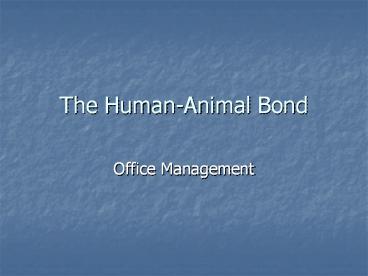The Human-Animal Bond - PowerPoint PPT Presentation
Title:
The Human-Animal Bond
Description:
The Human-Animal Bond Office Management Introduction Human-Animal Bond Definition- The American Veterinary Medical Association s Definition: A mutually ... – PowerPoint PPT presentation
Number of Views:413
Avg rating:3.0/5.0
Title: The Human-Animal Bond
1
The Human-Animal Bond
- Office Management
2
Introduction
- Human-Animal Bond Definition-
The American Veterinary Medical Associations
Definition A mutually beneficial and dynamic
relationship between people and other animals
that is influenced by behaviors that are
essential to the health and well-being of both.
This includes but is not limited to, emotional,
psychological, and physical interactions of
people, other animals, and the environment.
3
History of the Human-Animal Bond
- Human-canine bond is one of the oldest
relationships. - Domestication gt12,000 years ago
- Transition from working companion to pet between
600 to 1300 AD - Evidence of human-feline bonds 9,500 years ago.
- Farm animal domestication 10,000 years ago.
4
(No Transcript)
5
Pets or Family Members?
- 62 of US households have at least one pet (AVMA
2002) - Children are more likely to have pets than
siblings or fathers (Melson, 2001) - More than 75 of owners say dogs health is as
important to them as their own (Pfizer Animal
Health/Gallup survey)
6
(No Transcript)
7
More statistics and thoughts
- 57 would prefer their pet as their only
companion if they were stranded on a desert
island (2001 APPMA pet owner survey) - 52 are better at remembering the names of
neighbors pets than human neighbors (2001 AAHA
survey) - A scientifically established link exists between
how people treat animals and how they treat each
other
8
(No Transcript)
9
Finances on Pets
- 41 Billion was spent on pets in 2007.
10
(No Transcript)
11
How do Pets Function in Modern Society?
- Assistance animals
- Helpers (i.e. hearing, sight, seizure detection)
- Visitation
- Therapy programs (physical, mental,
skill-building) - Search and rescue dogs
- Bomb detection dogs
- Police dogs
- Police horses
12
(No Transcript)
13
Pets as Healers?
- Pet owners have
- Lower blood pressure, triglycerides, and
cholesterol - Increased survival after heart attack
- Stress reduction
- Weight control
- Fewer minor health problems
14
More Benefits to Humans
- Alzheimers patients allowed to observe fish
demonstrated improved relaxation, alertness, and
eating habits - Positive impact on the lonely, emotionally or
physically impaired
15
Benefits to Children
- Pets
- Provide a sense of security and self-esteem
- Facilitate play, exploration, independence
- Facilitate an understanding of life events and
life-changing events - Promote responsibility, nurturing, loyalty,
empathy, sharing, and unconditional love
16
Equine Therapy
- To give those in search of help and
self-discovery the opportunity to grow and
experience well being through the healing power
of horses.
17
- Animals in classrooms
- Motivate students to work well
- Improve behavior
- Provide care-giving opportunities important to
psychological development
18
Pets and the Elderly
- Pets
- Provide companionship and support during
bereavement - Increase levels of activity
- Improve person-to-person interactions
- Ease loss in natural disasters
- Transcend sensory deficits, mental changes,
mobility restrictions that can impede human-human
relationships - When moving to residential care, there are
significant benefits when elderly persons keep
their pets
19
Pets and Disasters
- A sense of personal responsibility to those
entrusted to our care is a hallmark of
emotionally and ethically mature human beings. - Owners are loyal to the animals they love, and
will risk personal injury to protect them. - Studies indicate that pet-owning households are
significantly less likely to evacuate during
mandatory orders than households without pets
the more pets, the less likely household will
evacuate. (AJE 2001 153659-665)
20
- Sometimes having pet and being able to care for
pet is the only stabilizing factor left by the
natural disaster.
21
(No Transcript)
22
Other Notes
- Generally pets are referred to as he or she and
almost never as it. - Most pet owners freely admit to talking to their
pet and feeling that their pet understands what
they are speaking about.
23
- http//www.youtube.com/watch?v5T-sLDb7YBw
- http//www.youtube.com/watch?voiGKWoJi5qMfeature
related - http//www.youtube.com/watch?vjcHM0Bg1j74
- http//www.youtube.com/watch?vGZc4Jks_f_Q































